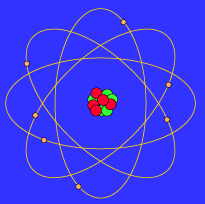Photosynthesis
An example of naturally-occuring biological oxidation-reduction reactions is the process of photosynthesis. It is a very complex process carried out by green plants, blue-green algae, and certain bacteria. These organisms are able to harness the energy contained in sunlight, and via a series of oxidation-reduction reactions, produce oxygen and sugar, as well as other compounds which may be utilized for energy as well as the synthesis of other compounds. The overall equation for the photosynthetic process may be expressed as:
6 CO2 + 6H2O --------> C6H12O6 + 6 O2
(glucose)
The equation is the net result of two processes. One process involves the splitting of water. This process is really an oxidative process that requires light, and is often referred to as the "light reaction". This reaction may be written as:
12 H2O -----------------------> 6 O2 + 24 H+ + 24e-
light or radiant energy
The oxidation of water is accompanied by a reduction reaction resulting in the formation of a compound, called nicotinamide adenine dinucleotide phosphate (NADPH). This reaction is illustrated below:
NADP+ + H20 -------> NADPH + H+ + O
(oxidized form) (reduced form) (oxygen)
This reaction is linked or coupled to yet another reaction resulting in the formation of a highly energetic compound, called adenosine triphosphate, (ATP). As this reaction involves the addition of a phosphate group (labeled, as Pi) to a compound called, adenosine diphosphate (ADP) during the light reaction, it is called photophosphorylation.
ADP + Pi ------------> ATP
Think of the light reaction, as a process by which organisms "capture and store" radiant energy as they produce oxygen gas. This energy is stored in the form of chemical bonds of compounds such as NADPH and ATP.
The energy contained in both NADPH and ATP is then used to reduce carbon dioxide to glucose, a type of sugar (C6H12O6). This reaction, shown below, does not require light, and it is often referred to as the "dark reaction".
6 CO2 + 24 H+ + 24 e- ------> C6H12O6 + 6 H2O
The chemical bonds present in glucose also contain a considerable amount of potential energy. This stored energy is released whenever glucose is catabolized (broken down) to drive cellular processes. The carbon skeleton in glucose also serves as a source of carbon for the synthesis of other important biochemical compounds such as, lipids, amino acids, and nucleic acids.
In simplest terms, the process of photosynthessis can be viewed as one-half of the carbon cycle. In this half, energy from the sun is captured and transformed into nutrients which can be utilized by higher organisms in the food chain. The release of this energy during the metabolic re-conversion of glucose to water and carbon dioxide represents the second half of the carbon cycle and it may be referred to as catabolism or "oxidative processes".
skip to main |
skip to sidebar


Bhor's atom model
Oxidation reduction reaction.
Search

Custom Search
How is this blog?
Blog Archive
-
▼
2009
(24)
-
▼
August
(24)
- Oxidation Reduction
- Oxidation states
- Definition of oxidation reduction
- Ionic compound
- Ionic formulas
- Electronegativity
- Electronegativity & Metal/Nonmetal CompoundsAs ind...
- Redox Reactions Involving Nonmetals OnlyThe situat...
- Guidelines - Oxidation States of Nonmetals1. When ...
- Types of redox reaction.
- Combination reactions
- Decomposition reactions
- Single displacement reactions
- Balancing Redox Reactions Using the Half Reaction ...
- Balancing Redox Reactions in Basic Solutions
- Bleaching Agents (Application of redox reaction)
- Photosynthesis (Application of redox reaction)
- Metabolism (Application of redox reaction)
- Nitrogen Fixation(Application of redox reaction)
- Combustion of Fuels (Application of redox reaction)
- The "Dry-Cell" Battery
- Electrochemical Cells (Application of redox reaction)
- Photo-oxidation - Photochromic Glass (Application ...
- Corrosion (Application of redox reaction)
-
▼
August
(24)
Labels
- . single displacement reactions (1)
- balancing redox reactions in basic solutions (1)
- balancing redox reactions using the half reaction method (1)
- bleaching agents (1)
- combination reaction (1)
- combustion of fuels (1)
- corrosion (1)
- decomposition reactions (1)
- definition of oxidation reduction (1)
- electrochemical cells (1)
- electronegativity (2)
- ionic compound (1)
- ionic formula (1)
- metabolism (1)
- nitrogen fixation (1)
- oxidation number (2)
- oxidation reduction (1)
- Photo-oxidation - Photochromic Glass (1)
- photosynthesis (1)
- redox reactions (1)
- the "Dry-Cell" battery (1)
- Types of redox reaction (1)
Image

Bhor's atom model

No comments:
Post a Comment